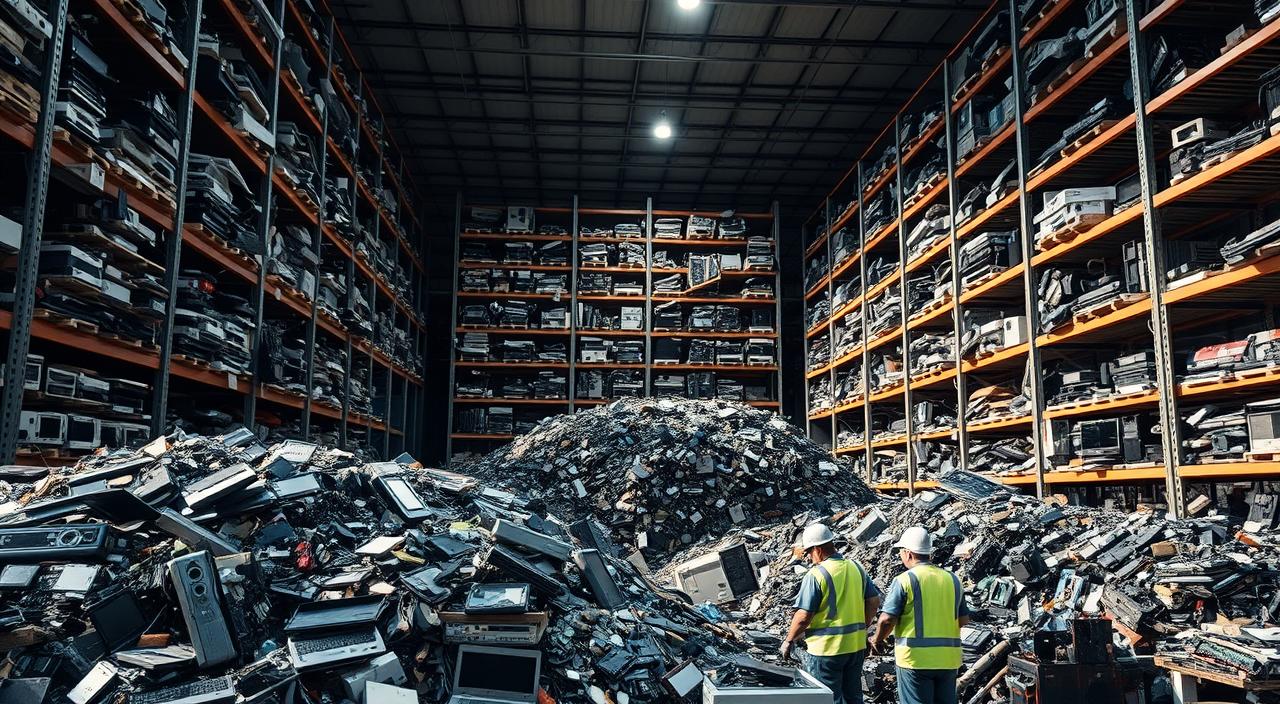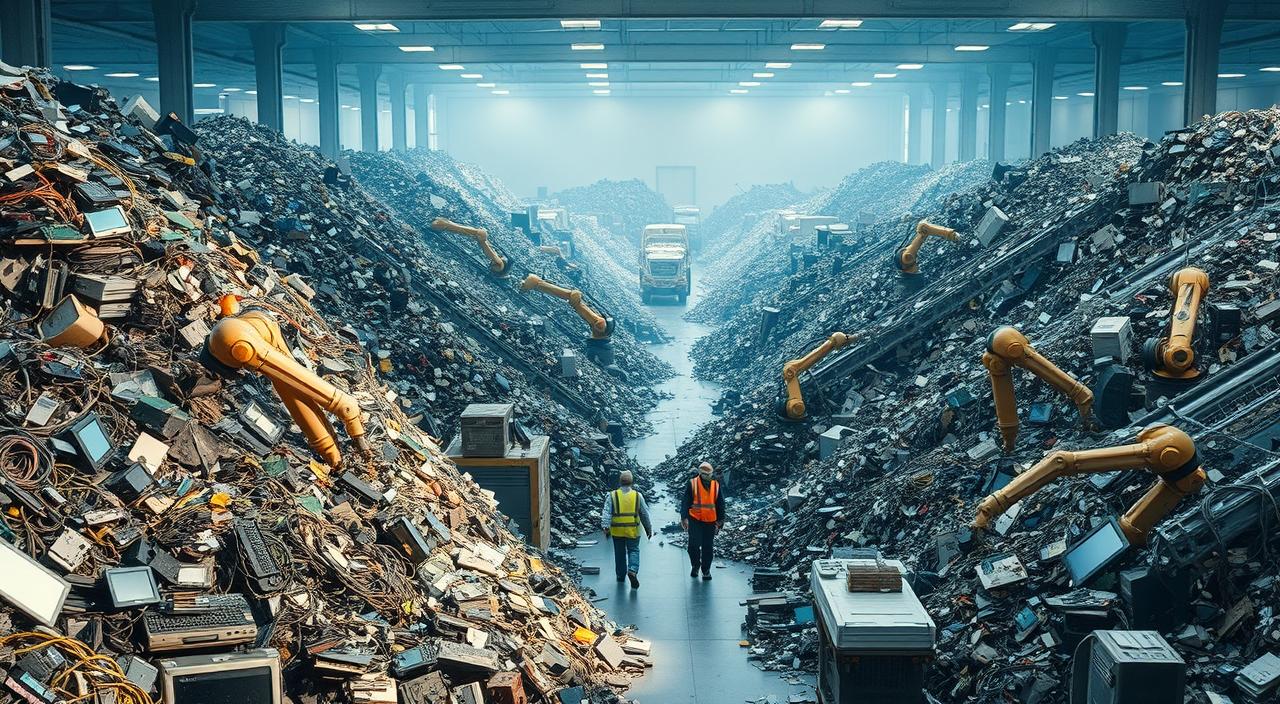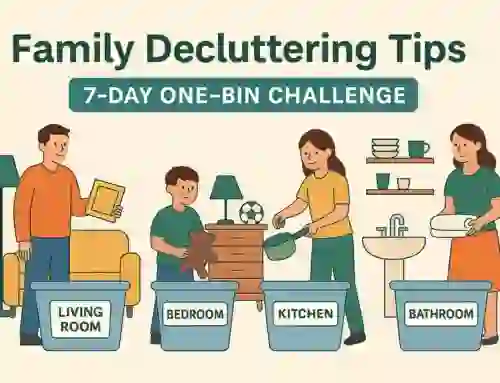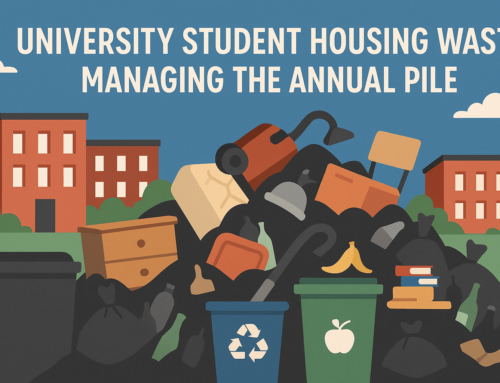Responsible electronics disposal is a growing concern in today’s tech-driven world. With millions of gadgets discarded annually, improper e-waste disposal leads to environmental pollution and resource waste. Whether you’re upgrading a phone or clearing out old laptops, learning how to dispose of electronics responsibly helps protect our planet and conserve valuable materials.

Key Takeaways
- Understand the global electronic waste challenge and its environmental effects.
- Learn proper recycling and disposal methods for old electronic gadgets.
- Discover reuse strategies before choosing to recycle.
- Explore the importance of data protection during disposal.
- Find certified UK recycling services for responsible e-waste management.
The Electronic Waste Problem
Electronic waste (e-waste) includes discarded devices such as smartphones, computers, televisions, and small household appliances. These devices become waste when they’re broken, outdated, or replaced.
Why It’s a Growing Crisis
E-waste is one of the fastest-growing waste streams globally. With constant product updates and consumer demand for the latest technology, the volume of discarded devices continues to rise. Without proper management, this waste contributes to toxic pollution, resource depletion, and climate change.
Why Responsible Electronics Disposal Matters
Discarding electronic items carelessly can:
- Release heavy metals like mercury and lead into the environment.
- Pollute soil and groundwater through landfills.
- Expose workers in informal recycling sectors to harmful substances.
- Waste precious materials like gold, copper, and palladium.
Benefits of Responsible Disposal
| Advantage | Impact |
|---|---|
| Prevents environmental toxins | Reduces risk of soil, air, and water contamination |
| Conserves valuable resources | Recovers metals and materials for reuse, decreasing mining activities |
| Reduces energy consumption | Recycling consumes less energy than manufacturing from raw resources |
| Supports data security | Ensures personal data is wiped from old devices |
How Improper Disposal Impacts the Environment

Toxic Materials in Devices
Common electronics contain:
- Lead and cadmium (circuit boards, batteries)
- Mercury (LCD screens)
- Brominated flame retardants (plastics)
These substances can cause respiratory illness, neurological damage, and long-term ecological harm.
Contamination of Ecosystems
Toxic leaching into water supplies threatens aquatic life, entering the food chain and affecting biodiversity. Wildlife and human populations near informal dump sites often suffer from increased health risks.
Valuable Materials Inside Old Electronics
Throwing out electronics also means discarding recoverable resources.
Metals You Can Reclaim
Old phones, laptops, and TVs often contain:
- Gold and silver (circuitry and connectors)
- Copper (wires and coils)
- Aluminium and palladium (casings and components)
Energy Savings from Recycling
Reclaiming copper alone can reduce energy usage by over 85% compared to traditional mining.
How to Prepare Your Devices for Disposal
Before recycling, take essential steps to safeguard your personal data.
Back Up Your Information
- Use external drives or cloud storage to save important files.
- Backup settings, contacts, photos, and apps on smartphones and tablets.
Erase Data Securely
- Use certified data wiping software for hard drives.
- Perform factory resets on mobile devices.
- Remove and destroy storage cards if necessary.
- Log out of all online accounts and disconnect from smart home networks.
Reuse Before You Recycle
Not all outdated gadgets are ready for the bin. Reusing extends product life and reduces demand for new electronics.
Donating Working Electronics
Non-profits and schools may accept used laptops or tablets. This extends their lifespan and bridges the digital divide.
Selling Used Tech
Use platforms like:
- CeX UK – for selling phones, gaming consoles, and laptops.
- Facebook Marketplace – for local buyers.
- eBay UK – for wide reach and bidding options.
Repurposing Old Devices
- Use a tablet as a digital recipe book or smart home hub.
- Turn an old smartphone into a security camera or music player.
- Convert a desktop into a Linux-based media server.
Electronic Waste Disposal Options in the UK
1. Manufacturer Take-Back Schemes
Many tech brands offer return or trade-in programmes. Some examples include:
2. Retailer Collection Programs
Retailers like Currys and Argos offer recycling when you buy a new product. Some offer in-store drop-offs for small electronics even without a new purchase.
3. Local Council Services
Councils provide Waste Electrical and Electronic Equipment (WEEE) collection points at household waste recycling centres. To find your local options.
| Disposal Method | Description | Perks |
|---|---|---|
| Manufacturer Schemes | Return old gadgets via mail or in-store | Often free, convenient, eco-certified |
| Retailer Drop-Off Points | Hand in when buying new devices | Encourages trade-ins and reuse |
| Council Recycling Centres | Designated facilities for WEEE collection | Supports local recycling initiatives |
Finding a Certified E-Waste Recycler in the UK

Always check for WEEE-authorised treatment facilities (ATFs). Look for Environment Agency permits and certifications.
Questions to Ask Recyclers
- Are you WEEE-compliant or Environment Agency-approved?
- Do you guarantee data destruction and issue proof?
- What percentage of items are reused or recycled locally?
- Are any devices or components exported?
Explore this official resource for verified e-waste recyclers: 👉 WEEE Authorised Treatment Facilities
How to Recycle Different Types of Electronics
Here’s a quick guide to help you recycle specific devices:
| Device Type | Key Tips Before Recycling |
|---|---|
| Computers & Laptops | Wipe hard drives, remove batteries, check for trade-in or reuse options |
| Phones & Tablets | Backup data, reset to factory settings, remove SIM/memory cards, donate or trade in |
| TVs & Monitors | Contact your local recycling centre due to hazardous components like lead or mercury |
| Small Appliances | Remove batteries, drop off at supermarkets or council sites with WEEE bins |
Safe Battery Disposal Practices
Batteries are classified as hazardous waste and must be handled carefully.
Where to Dispose of Batteries
- Use in-store bins at supermarkets like Tesco or Sainsbury’s.
- Local libraries often provide recycling boxes.
- Visit your nearest recycling centre with a dedicated battery drop-off point.
Never dispose of batteries in general rubbish or mixed recycling bins.
Understanding the UK’s E-Waste Legislation
The WEEE Directive
The Waste Electrical and Electronic Equipment Directive ensures electronics are recycled responsibly across the UK and EU.
| Who | What They Must Do |
|---|---|
| Manufacturers | Design repairable products and support take-back schemes |
| Retailers | Inform consumers and offer collection when replacing items |
| Consumers | Dispose of electronics at official WEEE sites or via approved schemes |
Retailers must accept small WEEE items without requiring a new purchase—this is known as the Distributor Takeback Scheme (DTS).
Reducing E-Waste in the Future
Preventing waste is even better than recycling.
Buy Greener Tech
- Choose brands committed to sustainability
- Look for modular and repairable products
- Prioritise energy-efficient models
Maintain & Repair
- Regular software updates and physical cleaning extend lifespan
- Replace parts like batteries or screens instead of buying new devices
- Visit community Repair Cafés for free repairs
Support the Right to Repair
Support initiatives that give consumers the ability to fix their electronics. This includes access to parts, guides, and service manuals.
Common Disposal Mistakes to Avoid
- Don’t bin old electronics: Hazardous components make this illegal and unsafe.
- Don’t hoard outdated devices: Valuable materials degrade over time.
- Don’t trust unverified recyclers: They may export waste to countries with poor environmental controls.
Conclusion
The responsible disposal of electronic devices is no longer optional—it’s essential. From secure data wiping to identifying certified recyclers, every step contributes to a healthier planet.
Take action today to reduce your digital waste footprint. Whether you donate, recycle, or repurpose, your choices shape the future of e-waste management and environmental sustainability.





